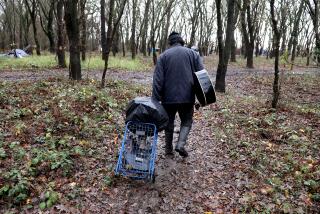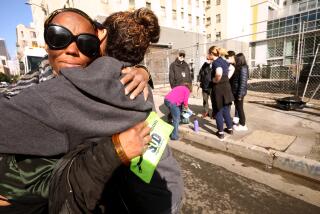Street Conversations With the Broken-Down Brigade
He’s in a wheelchair, ducking behind a trash can. I step forward to see if he’s OK and inadvertently scare him.
Sorry, I say.
“I wet myself,” the bearded man tells me. There’s a puddle under him on the pavement.
Wheelchairs are everywhere on skid row streets. Shiny and new or old and battered. Motorized or manual. Sometimes, when darkness falls and downtown empties out, wheelchairs own the road.
What kind of country treats its disabled and mentally ill this way?
How can we look the other way when the sick and the lame, the disabled vets and mangled castoffs are sleeping in wheelchairs on trashed and stinking skid row streets?
A couple of years ago, when I noticed the legions for the first time, I was at 6th and Towne. A priest was about to hand out blessings and dollar bills to a flock of hundreds. It looked as though a hospital had shut down and dumped its patients on skid row. Wheelchairs, crutches, walkers.
“God’s been good to me,” a man named Felix Jones said as he got his money from the priest. Jones had lost two legs to gangrene and was going blind on skid row.
Why the high spirits? I asked.
“I feel good in my heart,” he said.
Monday night, I decided to go find 10 people in wheelchairs, one after another, to see how they ended up here. The broken-down brigade.
No. 1: David Shannon, 68
He’s on Winston near Los Angeles, hunched comfortably in his chair, a blanket over his head. You quickly learn to sleep like that, he says, when options are limited and rats command the pavement. Next to him, another disabled man is rolling dice with the rodents. He’s out of his chair and on the sidewalk, out for the night.
“I got hit by a bus a while back,” Shannon says, and it aggravated an injury he suffered in 1957 as a soldier. Life has been no bed of roses, and one bad break after another put him here. “But I guess the old man can take it.”
No. 2: Lucille Reid, 56
She’s in her chair in the courtyard of the Midnight Mission, hoping to get a bed inside because it’s about to rain. A stroke put her in the chair in July. For a while, she and buddy Charles Muldrew, 59, a Vietnam vet, both lived in a single-room-occupancy hotel.
“It was roach-infested,” Reid says, so they fled.
While I’m talking to her, Mayor Antonio Villaraigosa appears. He had called me earlier about a young heroin addict I wrote about in the first part of this series. She died with no veins left for the paramedics to tap. He was also shocked by our story about the Porta-Potties being used as a brothel, just a block away from an LAPD station. He said he wanted to hit the streets with us Monday night.
How could I object? The whole point is to get some attention for the abomination we call skid row. It’s like the set of a Third World refugee camp, backlit by the L.A. skyline.
While Villaraigosa talks to Reid, who seems increasingly likely to be stuck out in the rain for the night, I go back on wheelchair patrol.
No. 3: Dorothy Kenyon, 67
“I’ve got two flat tires,” she says of her motorized chair. “I’ve got to get them fixed tomorrow.”
She’s already tucked into bed, one of the lucky ones who scored a cot at the Midnight, where she’s sharing a room with more than 50 people. The room set aside for families is overflowing again, so six children are sleeping out here with the adults.
“I’ve been homeless since January,” Kenyon says. Then, three months ago, “my kidneys collapsed and I fell over backwards.” Been in the wheelchair ever since. She’s wondering how she’ll pay to fix the flats.
No. 4: John Yost, 79
He’s a few beds away from Kenyon. His wife, an alcoholic, is out on the street. Yost’s legs gave out on him 10 years ago, after he and his wife moved to San Bernardino from Lebanon, Pa. Nothing has gone their way since. One thing I should know about people in wheelchairs, he warns, is that not everybody who’s got one needs it.
“They steal them,” he says, from people who do. Then they use them as carts or try to sell them.
I look around for the mayor, who’s talking to a young mother with three children. One boy is in a stroller he’s too big for, crying his eyes out. The woman tells Villaraigosa she voted for him.
A few minutes later, Midnight Mission publicist Orlando Ward tells Villaraigosa that conditions on skid row are the worst he’s seen in his seven years of working there. He sees mothers shooting up, and whereas one relatively docile gang used to control the drug trade, several gangs now compete, with bloodshed common. Ward knows of a guy on the street who sells dope he keeps hidden in his baby’s diaper.
Villaraigosa’s been doling out hugs at the mission, but Ward tells him to watch out. Disease is rampant, with a particularly nasty staph infection bouncing through prisons and shelters.
No. 5: Joe McMichaels, 62
He’s at Main and Winston, his left leg gone below the knee.
“I got hit by a truck,” he says. It happened two years ago.
“My leg is gone forever.”
I ask how long he’s been on the streets.
“I have a permanent mailing address,” he says. “In Pasadena.”
Tonight, maybe he’ll stay at a drop-in center on 7th Street.
Why not go home to Pasadena?
“I have a permanent mailing address,” he says again, and then he heads south on Main, using the worn heel of his shoe to pull himself slowly down a dark and lonely avenue.
No. 6: Adriana Arjona, 36
She’s making good time, rolling east on 5th in the middle of the street and banking left on Los Angeles. The rim of her left wheel is coming loose, creating the illusion of a lopsided wobble. A bag containing all her clothes hangs off one handle; a bag of birdseed dangles from the other. She likes to feed the birds.
Arjona says in Spanish that she was hit by a car six years ago and has been in the wheelchair ever since. She pulls up her pant leg and shows a scar from knee to ankle.
Someone gave her a painting of Our Lady of Guadalupe a while back, and, like a miracle, it brings her luck. She holds up the painting and passersby give her money. If she gets $40, she goes to a hotel. If not, to a shelter. Right now she’s headed to a shelter, but she gladly pauses and smiles proudly as she shows off Our Lady, her savior.
No. 7: Kenneth Bradley, 55
It looks like a wheelchair convention across 7th Street from Station 9, one of the busiest firehouses in the nation. Four wheelchairs are parked against a trio of Christian outreach storefronts closed for the night, and Bradley comes by in a fifth. A spinal infection put him in the chair two years ago, he says.
I look around and Villaraigosa is there again, taking it all in.
“I’ve counted about 25 wheelchairs,” he says.
I had been telling Villaraigosa that if you spend any time on skid row, you’ll see people lighting crack pipes and shooting up right in front of you. And now a man sitting on the street sticks a needle into the crease of his arm, looking for a vein he hasn’t already worn out. A few feet away, a man in a wheelchair lights a crack pipe.
Some of these folks are aware this is the mayor of Los Angeles standing here. To the junkies, it doesn’t matter who he is.
It’s the first time I’ve seen Villaraigosa speechless.
No. 8: Jerry Cano, about 40
Over the past several days, Cano has alternately yelled at me and thanked me for being on skid row. He has wanted to talk and wanted to wheel away. He was in a car accident in Culver City five years ago, he tells me.
“We have nothing to hide,” his girlfriend tells him, asking him to open up.
Cano looks depressed, angry and just plain tired.
“I don’t wanna be a junkie no more,” he says.
No. 9: Ronald A. Bedan, 65
He’s slumbering in the alcove of a taco shop but seems to wake up practically in mid-sentence, telling me about his career in corporate America, his clothing line in Canada and his plans to introduce a quality burger to the menu of the taco shop, which is owned by a friend and potential business partner.
The nearby intersection of 7th and Stanford is known for its transsexual prostitutes, but there’s not much activity there at the moment.
Bedan, wearing a Johnny Walker cap, says dizzy spells put him in the chair, and he’s spent 10 years on the streets.
A rough life, I tell him.
“It was rough for Jesus,” he says.
No. 10: Dewayne Jackson, 56
Emphysema ruined him, Jackson says. He used to work just across 5th Street, near San Pedro, at Jack’s Market. But now he can’t get around very well, and when he got back to his temporary room at the Weingart Center tonight, the doors were locked for the evening.
He’s going to have to sleep sitting up.
“I don’t wanna be out here,” he grouses. The rain is coming and all he’s got is a blanket.
It’s well past midnight when I tell him goodnight and good luck. As I begin to leave, a man comes toward me. He’s pushing a wheelchair with plastic roses on the seat. Both are for sale, the roses and the wheelchair.
“I’m the rose king,” Ali Gholani says, but he also sells wheelchairs. This one, he says, was given to him by a friend.
How much?
“Thirty dollars,” he tells me, saying it’s worth at least $80 or $100. “Thirty dollars, come on. It’s a good deal.”
Reach the columnist at steve.lopez@latimes.com and read previous columns at latimes.com/lopez
More to Read
Start your day right
Sign up for Essential California for news, features and recommendations from the L.A. Times and beyond in your inbox six days a week.
You may occasionally receive promotional content from the Los Angeles Times.







